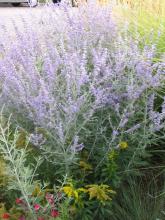
High Plains Gardening
The gardening website of the Texas High Plains Region

Russian sage is a must have shrub for every low water-use landscape. Russian sage is used extensively throughout our southwest landscapes, planted along with Buddleia, Carl Forester Reed Grass, Salvia greggii cultivars, Anisacanthus quadrifidis wrightii and Hesperaloe parviflora. It is hard to beat its use where a long flowering, showy, low care, drought tolerant shrub is needed.
Perovskia atriplicifolia, that is, having leaves similar to the atriplex, or orach (Atriplex hortensis, French or Mountain Spinach). Our native atriplex is A. canescens, or Four Wing Salt Bush, also known as Chamiso.
Though similar in pungency to sage or artemisias, it is not a sage, but is a member of the Lamiaceae, the mint family, as are the salvias. It's flowers bear a strinking resemblence to it's cousins, including the lavenders. Artemisias belong to the Asteraceae, or Compositeae family, whose members all bear daisy like flowers.
The yellow flower in the foreground is Solidago canadensis ‘Golden Baby’, a non-invasive goldenrod variety.
Full sun location. Xeric bed or border towards the back. Shrub bed or border.
Cut back the stems at winter's end. You may need to curtail it's spread. If so, just pot up some roots and pass along to friends, neighbors, co-workers, or anyone. This long-giving plant needs little to flourish, indeed, over amending and watering will make it floppy, destroying it character. Never fertilize.